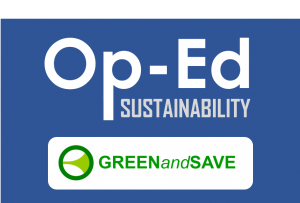- 26 reads

Our GREENandSAVE Staff is pleased to publish Op-Ed content from authors and influencer from the US and around the world. If you would like to submit an Op-Ed, please Contact Us. The maximum length for Op-Ed submissions is 750 words and approved content focuses on themes relative to energy intelligence and sustainability.
This Op-Ed written by Charlie Szoradi, CEO of the Energy Intelligence Center (https://energyintelligencecenter.com/) and Independence LED Lighting (https://independenceled.com/) Charlie@IndependenceLED.com
Why Businesses Should Take Energy Smart Action Now to Prepare for POST-COVID-19
If revenue drops, energy costs will become a surprisingly high percentage of profits and a reason to fast-tacking energy saving initiatives.
As an architect and energy-efficiency professional over the past three decades, I have seen how long it takes businesses that wait to decide on energy saving measures. America may have waited too long to impose social distancing and testing to prevent the spread of COVID-19, but we do not need to make the same mistake when it comes to the energy health of our companies. Many business owners and managers may feel powerless on the sidelines as federal and state government officials address the human and financial crisis. Now, businesses can stop waiting and start fast-tacking one or more energy-efficiency initiatives that will ease the pain of recovery and help yield profitability.
Energy cost is a significant factor in profitability. Each year, the U.S. spends about $1.1 trillion on energy, or 5.8% of Gross Domestic Product (GDP). The breakdown is as follows: Transportation 37%, Industrial 35%, Residential 16%, Commercial 12%. according to the U.S. Energy Information Administration. U.S. corporations have made just over $2 trillion in annual profits each year since 2012, according to Statista. I researched these numbers to be able to calculate the percentage of energy relative to corporate profits. Industrial + Commercial = 42% of the US energy use which is just over $420 billion. Given that annual corporate profits are about $2 trillion, the energy consumption is 21% of the profits. The tools and technology are readily available today to save a minimum of 25% of the energy costs, which drops to the bottom line and positively impacts profit.
Here are two examples of actual energy savings from technologies that have been available over the past decade. A hotel is saving $100,000 each year on energy costs by optimizing its air conditioning system, and a Beer Distribution Warehouse is saving $100,000 each year with light-emitting diode (LED) light fixtures. Air conditioning and lighting are referenced here, because together they often account for the majority of commercial energy consumption. They are the “low hanging fruit” of energy efficiency, and in many cases $0 upfront cost options are available to business owners as well as favorable rebate incentives from utility companies.
If POST-COVID-19 gross domestic product (GDP) is expected to drop in each quarter of the balance of 2020, profits could decline by 50% or more. Energy costs will rebound as work recommences, and corporate energy consumption could increase from 21% to 42% of profits. Corporate decision makers have a relatively limited number of levers to pull to impact profit, and energy savings is one to consider more seriously now than ever.
Action items to consider:
#1: If your business has proposals at hand for energy efficiency, set them in motion to fast-track the benefits.
#2: Get Tested – See where you stand by look at your company’s historical energy costs relative to profitability. Then, call in some energy “doctors.” Specialists range from HVAC optimization providers to lighting solutions companies. Many of them offer free assessments of current equipment and provide upgrade proposals with the potential annual energy savings and rebate incentives.
#3: Look for energy conservation measures (ECMs) with $0 upfront cost options, where you pay for the benefits as a percentage of the actual savings generated.
#4: Focus on net operating income (NOI) benefits over return on investment (ROI) paybacks. Saving energy is typically more cost-effective than producing it through renewables like solar and wind with longer term paybacks.
#5: Look for software and other ways to optimize existing systems rather than expecting that new equipment is the only path to savings.
#6: Do the little things like setting programmable thermostats and turning off lights in rooms that are not occupied. Many thermostats have capabilities that are not being used to their full capacity and too many buildings have lights on well into the night when only a few people are still working or the cleaning crews are using relatively small percentages of the area.
We use about 20% of the world’s energy in America with less than 5% of the population. We can all benefit by cutting energy fat to come out of this pandemic with a healthier energy footprint than before it stated. The results will also include reducing CO2 emissions and creating many new clean-tech and support service jobs for Americans along the way.
Beyond the Op-Ed:
For more information on Made in America LED Lighting and for HVAC Optimization, Charlie Szoradi is available at Charlie@IndependenceLED.com. During COVID-19, also see: Germicidal UV Light for HVAC ducts and Manual Optimization Methods for chillers, heat pumps, and process cooling.

